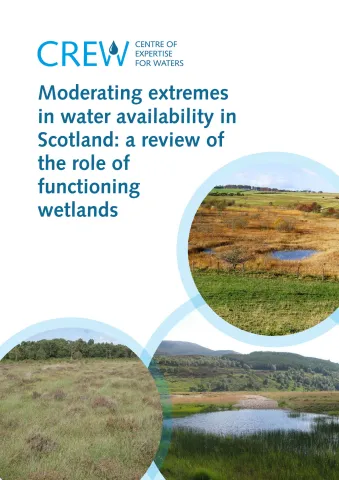Wetlands can be defined as areas of marsh, fen, or peatland with permanent or temporary water (brackish or freshwater). They cover an estimated 2 million hectares of Scotland’s land area from uplands to the coastline and are important for sequestering carbon, providing habitat, storing water, and maintaining biodiversity. When in good health, these wetlands can have capacity to buffer both high and low flows for moderating extremes in water availability (i.e., flood and drought risks respectively, both individually and in combination) which are predicted to become more frequent due to climate change. Yet the health of wetlands is under extensive pressure from land use conversion, management, and climate change. Furthermore, what has been missing up to now is an assessment of a broad range of wetlands with respect to their buffering capacities for both high and low flows. To improve wetland resilience, we also need to better understand the various impacts on such capacities, as well on their biodiversity.
The aim of this project was to review the role of functioning wetlands in moderating extremes in water availability in a Scottish context. A comprehensive assessment of the current and future buffering capacity to high and low water flows of the eighteen wetland types that occur in Scotland was undertaken. This used an interdisciplinary approach and synthesised information from the available literature, expert opinion, indicator data analysis, mapping visualisation methods, climate change scenario modelling and workshop participation for responding to the overall objective and four research questions asked. Assessments on the health, biodiversity, and ability to mitigate droughts and flooding was made across this broad range of wetlands. Wetland area extent was also mapped, and the impacts of climate change were assessed using models. This enabled an assessment of how the water holding and biodiversity characteristics of wetlands may be impacted by climate change. Together, these strands of work informed recommendations for creating, maintaining and restoring wetlands. The evidence on the ability of wetlands to buffer extremes of water quantity was often limited with the effects depending on the timing, location, and health of a particular wetland. Thus, a cautious assessment was made. It was found that most wetland types have a limited ability to moderate extremes in water availability, with particular wetland types like floodplain fens, swamps, wet woodland and reedbeds having the best potential. These should be prioritised for restoration especially in catchments that are at high risk of drought and flooding. However, given the poor health or loss of wetlands, it is expected that restoring all wetland types where opportunities arise will also improve mitigation. Climate change is expected to lead to wetter conditions in wetlands in the north-west with wetlands in the east becoming drier; the health of 10 out 18 wetland types and the ability to moderate water extremes, is at risk. More frequent drought is also expected to threaten rare plant species and 98 out of 700 species in the Scottish Biodiversity List are vulnerable to change which could in turn have impacts on the water holding capacity of wetlands. Some existing policies, such as the Flood Risk Management Act and Scottish Climate Change Action Programme, already provide support for maintaining and restoring wetlands. This project also made key recommendations, such as maintaining reliable funding, improving the planning framework, and redesigning agri-environmental schemes, for enhancing wetland buffering capacity in Scotland.
| Attachment | Size |
|---|---|
| CRW2019_03 Main Report | 957.42 KB |
| CRW2019_03 Appendices | 7.06 MB |
| CRW2019_03 Policy Note | 258.47 KB |
